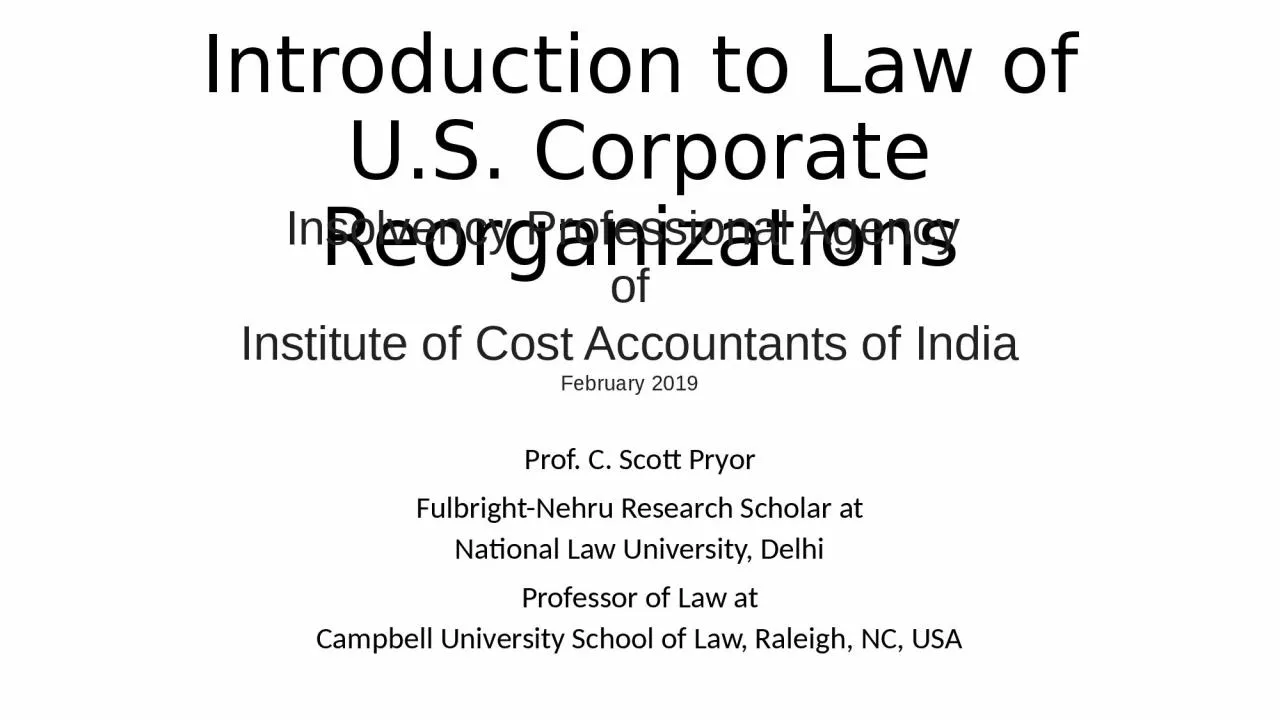

Prof C Scott Pryor FulbrightNehru Research Scholar at National Law University Delhi Professor of Law at Campbell University School of Law Raleigh NC USA Insolvency Professional Agency of ID: 1027363
Download Presentation The PPT/PDF document "Introduction to Law of U.S. Corporate Re..." is the property of its rightful owner. Permission is granted to download and print the materials on this web site for personal, non-commercial use only, and to display it on your personal computer provided you do not modify the materials and that you retain all copyright notices contained in the materials. By downloading content from our website, you accept the terms of this agreement.
1. Introduction to Law of U.S. Corporate ReorganizationsProf. C. Scott PryorFulbright-Nehru Research Scholar atNational Law University, DelhiProfessor of Law atCampbell University School of Law, Raleigh, NC, USAInsolvency Professional Agency ofInstitute of Cost Accountants of IndiaFebruary 2019
2. Personages in US Bankruptcy SystemBankruptcy JudgePart of the federal judiciaryNot part of companies/corporate law administration (not NCLT)Debtor-in-Possession in Chapter 11Management of pre-bankruptcy debtor remains in control of its assets and continues to run its business after filing Chapter 11 (Bankr. Code § 1107(a))Has most of the powers of a liquidation trustee (Bankr. Code § 1108)Has fiduciary duties to the bankruptcy estate and may be sued by creditors for violation of the duties of care and loyaltyMay be replaced by Bankruptcy Court with a managing trustee (similar to RP) but only for fraud or gross incompetence2
3. Personages in the Bankruptcy SystemCreditors’ Committee in Chapter 11“As soon as practicable” after filing, a committee of unsecured creditors shall be appointedTypically seven members drawn from volunteers among unsecured creditors holding 20 largest claimsEmpowered to investigate, negotiate, and advocate on behalf of all unsecured creditorsExpenses of members paid by estateWith approval from the Bankruptcy Court, Committee may retain its own legal counsel and accountants who will be paid by the DIP3
4. CLAIMS AND PRIORITYWhat Is a Claim? – Bankr. Code § 101: “(5) The term ‘claim’ means– right to payment, whether or not such right is reduced to judgment, liquidated, unliquidated, fixed, contingent, matured, unmatured, disputed, undisputed, legal, equitable, secured, or unsecured“All legal obligations of the debtor, no matter how remote or contingent, will be able to be dealt with in the bankruptcy case. It permits the broadest possible relief . . ..” (H.R. Rep. No. 595, 95th Cong., 1st Sess. 180 (1977))Basic Bankruptcy Concepts4
5. CLAIMS AND PRIORITY (WATERFALL)Basic Priority Scheme – Bankr. Code § 507(a): The following expenses and claims have priority in the following order:Administrative expenses…WagesEmployee benefits...Certain taxesBasic Bankruptcy Concepts5
6. Corporate ReorganizationLife Cycle of Corporate Chapter 116What Must Be FiledRights, Powers, and Duties of a Debtor-in-PossessionCash Collateral and Debtor-in-Possession FinancingSales Outside Ordinary Course of BusinessPlan of Reorganization Disclosure StatementClassification of Claims and VotingConfirmation of PlanCram-Down of PlanPost-Confirmation
7. Corporate ReorganizationLife Cycle of Corporate Chapter 117Rights, Powers, and Duties of a Debtor-in-Possession – Bankr. Code § 1107(a): DIP has all the rights and powers, and shall perform all the functions and duties of a trusteeIf DIP fails to take seriously its fiduciary obligations, creditors may seek appointment of a managing trustee (RP)If management of DIP violates its fiduciary duty of loyalty, creditors or subsequent liquidation trustee may sue for damages
8. Corporate ReorganizationLife Cycle of Corporate Chapter 118Plan of Reorganization – Bankr. Code § 1123The plan shall address 8 mandatory mattersThe plan may provide for 6 permissive matters (in fact, Bankruptcy Courts have allowed plans to address more than the permissive items listed in the statute)What Is a Plan?A plan is a an agreement between the DIP, its creditors, and its equity holders that provides terms for emergence from bankruptcy, including treatment of their respective claims and interests
9. Corporate ReorganizationLife Cycle of Corporate Chapter 119Plan of Reorganization – Process and ProcedureCore issue is usually cash flow: The troubled company’s cash flow is too small to service debt and pay variable (costs of goods sold) plus fixed (overhead) obligationsHow does Chapter 11 address this issue?Excess expenses, such as leases and losing contracts are addressed during the case by rejectionPlan of Reorganization looks to restructure debt service
10. Corporate ReorganizationLife Cycle of Corporate Chapter 1110Plan of Reorganization – Process and ProcedureCore issue is usually cash flowBankruptcy cannot grow money!The final question: Can the restructured debtor make its anticipated net revenues cover the new debt service?
11. Corporate ReorganizationLife Cycle of Corporate Chapter 1111Classification of Claims and Voting– Bankr. Code § 1126(c): a class of claims has accepted a plan if creditors that holdat least ⅔ in amount, and> ½ in numbervote to accept the plan
12. Corporate ReorganizationLife Cycle of Corporate Chapter 1112Confirmation of Plan – Bankr. Code § 1129(a): The court shall confirm a plan only if all of the following requirements are met:…With respect to each impaired classEach holder of a claim has either (i) accepted the plan or (ii) will ultimately receive under the plan payments the present value of which is at least as much as it would have received under a Chapter 7 liquidation [the “best interests” test]Proof that payments under plan > liquidation value requires evidence from cost accountants and valuators
13. Corporate ReorganizationLife Cycle of Corporate Chapter 1113Confirmation of Plan – Bankr. Code § 1129(a): The court shall confirm a plan only if all of the following requirements are met:… FeasibilityWill the restructured debtor have sufficient net income to service its restructured debt obligations?Requires evidence from accountants and valuators